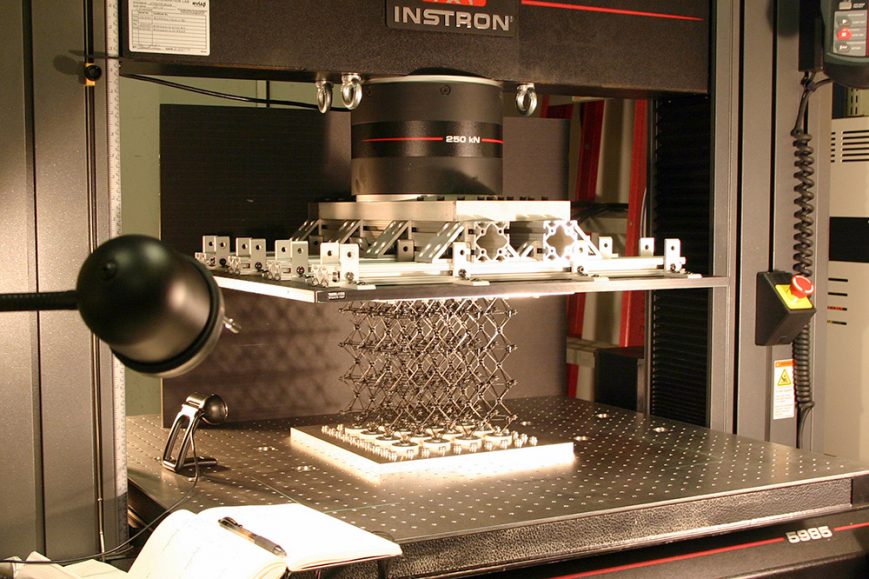Building blocks of the future
New lightweight, X-shaped blocks could be used to make cars, planes, buildings — and even spacecraft

A structure made from strong, small X-shaped blocks can support a lot of weight before it crumples.
CC-BY-NC-SA Kenneth C. Cheung
Any child who has played with blocks knows why they’re so useful. Kids can build almost anything from them — a plane, a castle, even a racecar. And if part of a creation comes apart or breaks, the builder doesn’t have to start from scratch. She can just replace the missing blocks. And what’s true for kids’ play is also true for adult projects. Here’s one new example, and it doesn’t even look like a “block.”
Scientists have just created a new building “block” that resembles the letter X (except that it has a hole in the middle and loops at the end of each arm). They may look like toys, but appearances can be deceiving. These pieces are small and lightweight yet strong. And they’re inexpensive. One day they may be assembled into bikes, bridges, planes or buildings.
Just as with toy blocks, if one piece breaks, engineers can swap it out without scrapping the whole project. Materials scientists Kenneth Cheung and Neil Gershenfeld at the Massachusetts Institute of Technology, in Cambridge, describe their new material in the August 16 issue of the journal Science.
Rainer Adelung calls the idea “fascinating.” A materials scientist at Kiel University in Germany, he did not work on the blocks. “When you read [about this invention],” he told Science News, “you think: ‘Why hasn’t anyone done this before?’”
Materials scientists use knowledge of existing materials to design new ones. The material used in the new X blocks is often called, simply, a composite. Engineers took carbon fibers, each thinner than a human hair, and wove them into a hard plastic substance.
Manufacturers already rely on larger composite pieces for many ultralight bicycles and luxury cars. Recently, aircraft builders also became interested in using big composites to build large sections of their planes. Five years ago, the company Sprint AeroSystems approached Cheung and Gershenfeld for help. It wanted some basic, big composite piece for an airplane. Cheung had his doubts about whether this was a good idea. If one part of the big piece broke, the problem might spread, leading to a more catastrophic breakup of the material.
Instead, his team at MIT decided to create smaller composite pieces. They envisioned an airplane built from millions of identical blocks — the new X blocks. Those described in Science are only 5 centimeters (2 inches) across, but each block could be made much bigger. “You can think of it as a really high-performing Lego,” Cheung explains.
In the lab, he connected the blocks to make triangular pyramids. Then, he connected the pyramids to create a cube about 20 centimeters (8 inches) across. The cube weighed only as much as an egg, but supported more than about 295 kilograms (650 pounds) before crumpling.
His group built other structures, too. And when those broke, they didn’t completely fall apart. Instead, the scientists could make repairs by exchanging new blocks for the broken ones.
The composite blocks aren’t as strong and stiff as other, denser construction materials, James Tour told Science News. This materials scientist works at Rice University in Houston, Texas. Because the new X blocks are so light, however, he does find them exciting. One reason: “Weight is a huge, huge concern” for cars and planes, he explains. It determines how much fuel they will use.
The new, high-tech X blocks may also find use out of this world. In September, Cheung heads to the space agency NASA. His plan? To design X-block structures that astronauts can deploy in space.
Power Words
carbon The chemical element having the atomic number 6. It is the physical basis of all life on Earth. Carbon exists freely as graphite and diamond. It is capable of self-bonding, chemically, to form an enormous number of chemically, biologically and commercially important molecules.
composite (also called a carbon fiber reinforced polymer) A lightweight, hard and strong plastic embedded with tiny fibers of carbon. Engineers use it to build lightweight bodies for racecars and airplanes, among other things.
materials scientist A scientist who studies how the atomic and molecular structure of a material is related to its overall properties. Materials scientists can design new materials or analyze existing ones. Their analyses of a material’s overall properties (such as density, strength and melting point) can help engineers and other researchers select materials that are appropriate for a particular use.